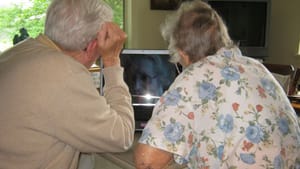Stay in the Loop
BSR publishes on a weekly schedule, with an email newsletter every Wednesday and Thursday morning. There’s no paywall, and subscribing is always free.
Why Gramps should use an iPad
Seniors and technology: a second look

Tom Purdom says a nice restaurant dinner with friends and a good bottle of wine is worth a thousand tweets. But since one of the first things he admits in the same essay is that he doesn’t use Twitter, I wonder how he knows what a tweet is worth, let alone a thousand.
He’s not alone — there are plenty of writers who decry social media without having actually used it, and Tom’s right: This attitude isn’t a phenomenon of age but of temperament. In acres of paragraphs, the social-media averse say any statement limited to 140 characters or less can’t possibly be worthwhile. Abbreviations and acronyms thus spawned are a sign of the End Times; punctuation turned into little faces peeping at you among the words is anathema to proper communication.
I love a good dinner out as much as anybody, but I’d be remiss if I didn’t also mention that without Twitter, I never would have had the chance to debate the finer points of the original Iron Chef TV show with Food Network star Alton Brown.
By his own count, Tom’s been using a computer as long as I’ve been alive, so I also dislike stereotypes about people one and two generations ahead of me being techno-dunces. My grandfather, age 87, embraced the digital age as it suited his needs, staying in touch with the whole family (now numbering four extremely peripatetic generations) via email and keeping up with his stock portfolio online.
Forgetting tech’s middle ground
I have an iPad and a smartphone (the latter reluctantly acquired about two years ago when my old phone, with no Internet but real buttons, gasped its last breath). However, unlike many people, I don’t abandon my phone every few months for a thinner, faster model. The one I’ve got works perfectly well, pelting me with its brisk vrrmp-vrrmp and chime every time someone somewhere in the world, from Johannesburg to Ireland to Abington, decides he or she needs to speak with me, via Snapchat or WhatsApp or Facebook or Gmail or a plain old-fashioned text message.
And Tom’s way ahead of me in the e-book department. As a writer, I spend so much time looking at screens that my retinas rebel at reading books on a screen. I want to smell paper, turn pages, fold corners, and trade with my friends. You can have my books when you force me to incinerate them, Fahrenheit 451-style.
But like many tech-leery writers, Tom reveals a lack of understanding for the role these technologies can play in our lives. Like any other form of communication, smartphones, tablets, and their myriad apps and social media platforms are as nuanced as their users.
“If I bought a smartphone and spent my days taking selfies and texting everybody I knew every ten minutes, I would have to spend less time writing, reading, and taking advantage of Philadelphia’s artistic riches,” he says.
Do you know the tools you need?
But that’s a false choice. I use my smartphone a lot, but take very few selfies, and then only to notify my networks of something really momentous, like a haircut that deserves at least 30 likes. Yes, I spend time texting, but smartphones have this magical button that renders them totally silent at the user’s will. It even works inside restaurants, theaters, museums, and concert halls, which I continue to enjoy just as much as I did before I had a smartphone — and I still write hundreds of articles a year.
“Technology is a tool. I buy new technologies because I think they will help me fill needs or satisfy desires,” Tom says of why these gadgets aren’t a fit for him, but I’d advise folks of any age to remember that a lot of the most important and useful things in our lives don’t get there because we anticipated the need for them.
Skype, sketches, and eagles
My other grandfather, now 89, couldn’t have told you what Skype was, but when his sister moved to the opposite coast so her daughter could care for her, a laptop set up by his kids and grandkids let him talk to his sister face-to-face every week.
His other sister, my 91-year-old Great-Aunt Doreen, whom I cared for weekly in the last year of her life, never would have guessed that she needed or wanted an iPad. She didn’t even know what an iPad was.
She was the world’s most avid bird-watcher. When she became homebound, I put my iPad on her lap and turned on a live-stream of an eagles’ nest at a Midwestern nature center. She was enthralled, speaking to the eaglets as if they were in the room.
“Where’s that magic box of yours?” she’d ask when I arrived, even though she couldn’t remember whether or not she’d eaten lunch.
She was an artist, too — a photographer, poet, orchestra trumpet player, and painter.

Her eyes and memory were failing, but I put the iPad’s bright screen in her lap, and showed her how to make lines with a touch of her fingertip in a simple digital paint program. She drew the last picture of her long life: a person walking with a bucket of feed to a busy birdhouse.
I saved it and shared it online with the family after she died. It wasn’t a function of the tablet that anyone anticipated needing.
I hope this isn’t the “techno-snob harangue” that Tom rightfully dreads. I look at these technologies not just in terms of needs and self-serving desires, spreadsheets and ease of typing, but in terms of the opportunities you can’t predict.
At right: Aunt Doreen's last drawing, thanks to an iPad.
Sign up for our newsletter
All of the week's new articles, all in one place. Sign up for the free weekly BSR newsletters, and don't miss a conversation.

 Alaina Johns
Alaina Johns